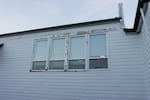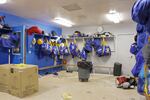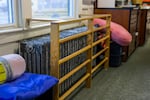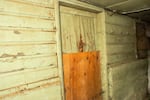The high school has needed a new roof since the 1990s. Middle schoolers spend their days in portable classrooms. The intercom doesn’t work throughout the buildings and some classrooms get as cold as 50 degrees. The schools in this Willamette Valley town are in such rough shape that the school board plans to close them, if voters don’t agree to a tax measure next week.
Related: OPB's Ballot Guide: What you need to know about Oregon's May 21 primary election.
Voters in the Gervais School District are deciding whether to approve a $28 million capital construction bond that district leaders argue is the final straw before the 1,260-student community closes.
More than half of the students in Gervais, a small district between Woodburn and Salem, are Hispanic or Latino, and more than 80% qualify for free or reduced-price lunches based on family income. Gervais students perform above the state average on some key indicators, including higher graduation and attendance rates.
Local educators want to continue serving these students, but they argue they’re running out of ways to do that.

Water damage is seen around windows at Gervais Elementary School. The Gervais school board has said they are prepared to close the entire district if a proposed $28 million bond to fix schools fails on the ballot for May 21, 2024.
Courtesy of Gervais School District
Gervais’ last successful bond passed in 1991, totaling $1.3 million. This money was used to build a cafeteria and gym at the elementary school.
Since then, Gervais school leaders have asked voters to approve bonds eight times. They’ve asked for anywhere from $4 million to $34 million for a variety of projects. Voters rejected all of them.
District leaders say this is the ninth and final attempt.
“As we look at these buildings that we can’t fix, because we don’t have the funding, you know, something has to give,” Superintendent Dandy Stevens told OPB. “We cannot have students going to school in buildings that are literally falling apart around them.”
What is Gervais asking voters to pass?
The ballot measure is asking voters to consider a $28.1 million bond. It would be paid off over 25 years, costing taxpayers $1.85 per $1,000 in assessed property value.
District officials said this is less than most of the neighboring school districts, which average closer to $2.37 per $1,000 assessed value.
A home’s assessed value is different and typically lower than what a house could be sold for, also known as “market value.” A bond calculator on the Gervais district’s website uses a home assessed at $145,000 as an example, concluding the owner would pay about $268 a year or roughly $22 per month, if the bond passed.
The money would be combined with a $6 million Oregon School Capital Improvement Matching grant, known as OSCIM. The state contribution is only given if the local bond measure passes.
In total, if passed, Gervais would have about $34 million at its disposal to make repairs.

A trash barrel sits in the middle of an outdated locker room at Gervais High School.
Courtesy of Gervais School District
The money would be used for major infrastructural changes, not annual maintenance, which is largely paid for annually out of districts’ general funds from the state.
Unlike many other districts in the region, Stevens — who has led the district for five years — said Gervais’ general fund is in good shape; they aren’t facing layoffs. But there’s not nearly enough money in their general funds to make the necessary repairs to Gervais’ facilities.
Stevens said the Oregon Department of Education gave Gervais a presentation in the fall, making it clear that what districts get annually is meant for yearly operational costs. She said ODE confirmed that this money is insufficient for any school district to do anything more than maintenance.
And Gervais does their yearly maintenance. Stevens said they have an independent third-party report that says the district “has done a great job of taking care of what we have, but that like everything, it’s just now worn out, and it’s time to be replaced.”
“We want to make sure people understand that this is not a band-aid,” Stevens said. “What this does is that it takes 30-plus years of not having a bond and brings all of our facilities up to where they need to be.”
Where would the money go?
The money would be used for new roofs, windows and sidings, plumbing and electrical repairs, and HVAC upgrades. It would also be used for increased security needs, such as secure front entryways, cameras, fencing and improved accessibility for people with disabilities.
This would be spread out across all three Gervais schools, and go toward some district-wide improvements. But the biggest portion — nearly $19 million — would create a middle school.
Right now, Stevens explained, Gervais Middle School consists of two modular buildings: one from 1999 and another from 2013. The bond would allow them to contract a stick-built middle school, with a cafeteria, kitchen, two science classrooms, two general education classrooms and a library media space.

Railings stand in place around a Gervais Elementary School radiator to minimize fire and safety risks.
Courtesy of Gervais School Distirct
Stevens said the current state of the schools often leaves students and staff uncomfortable in the classroom. Students at the elementary school — where the boiler system is so inefficient that it can’t regulate temperatures from one end of the building to the other — may endure rooms as cold as 50 degrees or as hot as 90 on the same day.
At the high school, students have to move their desks and their books to avoid water dripping through the ceiling from the leaky roof. She added, “There’s buckets everywhere.”
Stevens is sure more issues will be discovered when they start the remodel. They’ve been pursuing a new roof for the high school for 30 years, she said, so they know there will be significant water damage.
In terms of safety currently, Stevens said the intercom systems don’t work throughout the buildings.
“If you’re trying to do mass communication to people about a fire drill or some other kind of safety issue, you need to be able to communicate with people,” she said.

Damage to the Gervais High School roof has been an issue in the Oregon district for roughly 30 years.
Courtesy of the Gervais School District
Stevens added the buildings were not created with the type of security that buildings are created with now — such as cameras and automatically locking doors.
“While we have some items, we’ve definitely had to piecemeal those together,” she said. “As with anything, you can only piecemeal it together for so long before you really need to start with new and make everything uniform.”
Garnering voter support
When asked why Stevens thought voters haven’t supported a bond measure in the past, she pointed to a few factors — low voter turnout, aversion to taxes, a misunderstanding of school funding and a wave of first-time homeowners who haven’t had to pay bond taxes before.
She also said there’s a general mistrust of government these days, which they’ve tried to combat by clearly showing how taxpayers’ money would be protected and used in the bond.
Stevens said she’s “cautiously optimistic” that this time will be different. The school board polled about 500 local voters after the failed bond attempts in 2022 and 2023. This year’s bond proposal was created with that feedback.
There’s a newer, more organized political action committee behind the efforts this time too, playfully titled “Bond. Gervais Bond.” The group has received just over $13,520 in cash and in-kind contributions this calendar year.
Stevens has offered personal office hours for people to ask her questions about the bond, and proponents have made themselves available out in the community to do the same.
There’s no organized opposition to the bond, she said, and no opposing statements in the voters’ pamphlet. There were two statements of support, including one from the licensed and classified staff of the district.
Stevens said Monday there’s already been a higher rate of return on ballots cast, giving her hope. Any opposition she’s seen, such as comments online, has generally been people who are simply against taxes, she said, or who think the school board is bluffing that they’ll close if the bond doesn’t pass.
“The board’s response to that is: they’re all … well-respected members of the community. Why would they bluff?” Stevens said. “They’re trying to be transparent in saying, ‘We all have choices. And with choices, here are the possible consequences.’ "
What happens if the district closes?
If the bond passes, the district plans to hit the ground running in July, Stevens said, adding that 80% of the bond dollars have to be dedicated within three years. She said they plan to have the majority of the projects done by 2027.
But if the bond doesn’t pass, next year would be the last school year for Gervais. The board intends to have the last operational day of service for the district on June 30, 2025.
The district would be closed and consolidated with the five neighboring districts — Salem-Keizer, Woodburn, Silver Falls, St. Paul and Mt. Angel — with kids going to schools in five different directions starting that fall.

Building damage is documented at Gervais Elementary School in Oregon.
Courtesy of Gervais School District
Employees, including Stevens, would lose their jobs if they couldn’t be absorbed into the other districts. That’s especially alarming given the layoffs happening in neighboring districts like Salem-Keizer.
“This would be a terrible thing to happen to the community,” Stevens said. She touted the district’s response to heightened issues since the pandemic as “phenomenal” and something other districts have modeled themselves after. She took pride in the district’s culture and support for English language learners especially.
“The main hub of Gervais is the school district,” she said, adding they’re the major employer in town. “If there’s not something happening within one of the school buildings that involves children, the buildings are being used for community purposes.
“To have that not existing anymore would really be damaging for our community.”
But Stevens said they don’t see another solution.
Revenue-boosting steps that other districts have pursued, such as becoming a charter district, wouldn’t work for Gervais, because that still wouldn’t generate the money necessary to solve the building issues.
The district will have to get a new facility assessment done if the bond measure doesn’t pass in order to be eligible for the state’s matching $6 million OSCIM grant again, which would take at least 18 months. This continued delay in construction, Stevens said, only drives the cost of the projects up.
And, based on their community polling from last year, the school board believes there is no other project configuration or dollar amount that would be supported by the voters.
“It’s really about creating facilities that meet the needs of what would be considered a 21st-century education,” Stevens said, “and giving our students the opportunity to have the same kinds of facilities that their peers and other districts have.”
